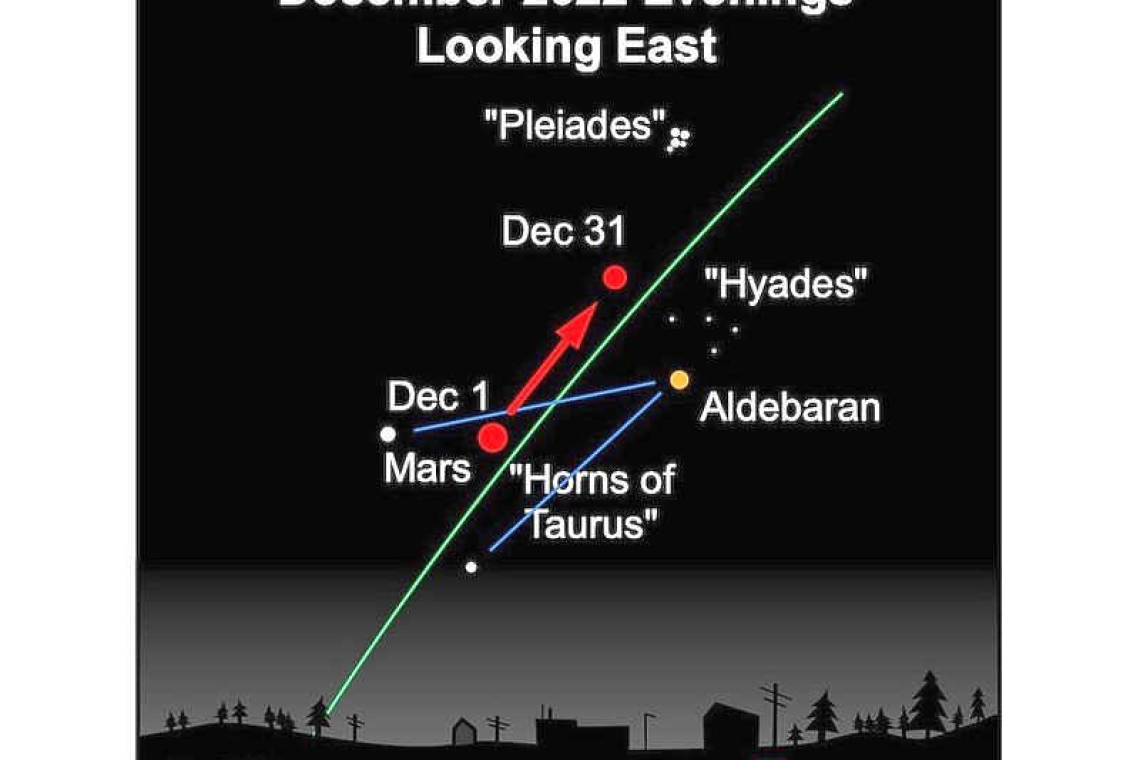~ St. Maarten’s Backyard Astronomy for December 2-4 ~
Sun rises at 6:28am
Sun sets at 5:35pm
Lunar phase: 2nd quarter, waxing gibbous
Moon sets at 1: 34am, Saturday
Moon rises at 2:42pm, Saturday
This weekend, break out the telescope or a good pair of binoculars because the moon, the stars and planets are all on display in the early evening hours. You can find Mars rising from the eastern horizon as soon as the sun sets and the sky fades from blue to black. The red planet sits between the horns of Taurus the Bull. The moon is already high above Mars and if you take an imaginary line from Mars to the Moon and continue the line diagonally, up and to the right, you will be directed to Jupiter and then Saturn. Jupiter sits between Pisces and Aquarius this Saturday night, and Saturn is held within the constellation of Capricornus. Planets can be fascinating when magnified; you can detect surface features, atmospheric features, and sometimes even the moons that orbit the planet.
Turning to the northern sky, you can find Ursa Minor, or the Little Dipper, low to the horizon. Above the dipper you can find Cassiopeia sitting halfway up the sky, representing the queen upon her throne. Cassiopeia is easy to spot – look for five stars in a zig-zag. As she rotates around the Little Dipper, the shape takes on the form of a letter “W” or “M” or sometimes a “3”, either forwards or backwards. As Cassiopeia sets, the Big Dipper rises. But that won’t happen this weekend until around the midnight hour.
Looking westward after sunset, check out two great bird constellations: Aquila the Eagle, and Cygnus the Swan. They will set early, after 9:30pm, so Aquila is gone and Cygnus is sinking quickly. While they are up, though, these two stretch out their wings, as if soaring up towards the zenith point of the sky where the Great Square of Pegasus holds court. Look just south of Pegasus and you’ve come full circle, back again to the planet Jupiter.
Later in the week, look for the moon to grow bigger and brighter, nearing its full-round and impressive stage. By Tuesday, the moon will have shifted its location to a spot very close to Mars and the bright star Aldebaran, known as the Bull’s Eye of Taurus. The full December moon officially comes this Thursday, and it is known as the Cold Moon.
Those of you currently visiting our island may be familiar with why the full moon of December earned this name – we islanders associate “cold” with “beer”. So why not enjoy the full moon on Thursday with an ice cold beverage of your choice?
Thank you for keeping up with the Night Sky articles, backyard astronomy designed for St. Maarten sky viewing. FYI: If you are out later on in the week, note that each star rises about four minutes earlier each day than written here, and the moon rises 50 minutes later. Night Sky is researched and compiled by Lisa Davis-Burnett. Earthsky.org is a key resource for information and images. Questions or comments? Email This email address is being protected from spambots. You need JavaScript enabled to view it.







